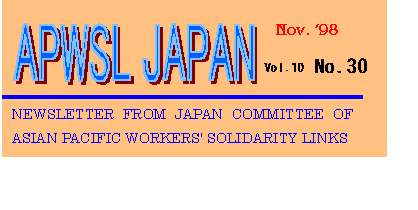

APWSL Aotearoa Visits Japan on Exchange Program in August
Personal Proposal to APWSL@@ from Ben Watanabe
Thai Exchange Program Report
NGO Corner: Foreign Laborers Union
The Plight Japanese Brazilian Workers in Japan's Recessi
on Report on Postal Workers Exchange Visit to Aotearoa/NZ
October AGM Report
CMI Flight Attendants Dispute Resolved
@
@
@
@
We received a letter of request
from APWSL Aotearoa/NZ at the end of last year, in which they
told us that the workers of Juken Nissho Limited (JNL) in Kaitaia
on the north island had a struggle against the company's demands in contract negotiations
concerning their working conditions, and the union successfully
pushed the offer back.@ During the struggle they got support
from Japanese workers and they hoped to come to Japan to express
their thanks to their Japanese supporters and also hope to visit
the parent company of JNL, Juken-Sangyo, in Hiroshima to see
managers and workers.@ This letter was just the beginning of
the exchange program between Aotearoan and Japanese workers this
summer.
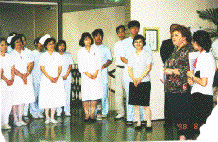
The Japan committee did what it
could to arrange a meeting with Juken Sangyo but, unfortunately,
the wish of the two workers from JNL who came to Japan with two
other members of APWSL Aotearoa could not be fulfilled, as both
the managers and the labour union there refused our offer.@
However, we were able to arrange for the four participants to
fulfill another wish when they attended the Commemoration
Ceremony for Atomic-bomb Victims on 6 August in Hiroshima.@ The
participants also visited Tokyo and Osaka on their tour and many
people were happy to see the familiar faces of the APWSL members
whom we had met when we visited New Zealand on our 3 Alternative
Tours in the last 3 years.@ In planning the itinerary, the
APWSL Japan committee tried to find a way to fulfill each the
individual wishes of the 4 New Zealand participants.@ We may
have gotten overenthusiastic in planning the program, but we
hoped to introduce the four to Japanese culture since they were
all first-time visitors to Japan, and also we hoped to let them
know more about the Japanese workers' daily lives.
The group arrived on Saturday, August
1, and the program in Tokyo started the next day with a half-day
introduction to Japanese labour issues and other current problems
in Japanese society.@ This was very useful to in order
understand the lectures and tours of the places we visited on our
itinerary in Tokyo.@ Except for the visits to the offices of
IFBWW and a Upper House Diet Member, most of the places visited
focused on how workers live and work.@ In response to the wish
of Mr. Pat Hira, a Maori, we met some Ainu, an indigenous people
of Japan; to the wish of Ms. Sue Wetere, a home helper who is
interested in social welfare, we visited a nursing home for the
elderly; to the wish of Ms. Colleen Symmonds and Pat, workers at
JNL, we visited lumber factory; and to the wish of Mr. Phil
White, we visited a community union.@ Those visits were very
useful for all of us, as the problems in each sector of society
are deeply connected.
@There was a chance for sightseeing
and recreation too.@ The 4 participants visited Asakusa, a
traditional entertainment area in downtown Tokyo and a hot
springs bath house near Tokyo Bay.@ On the other hand, during
their stay in Tokyo, one of the biggest cities in the world, they
had to experience how much walking we do going to and from train
stations and transferring between train lines.@ We hardly think
about it in Japan but we could see how tiring it was for our
guests.
The Hiroshima program was prepared
very carefully and kindly by some postal workers there who
visited Aotearoa/NZ in May. The four must have had a memorable
time visiting the Atom-Bomb Museum, an A-bomb survivors' nursing home, and on the morning of August 6
they@ attended the Commemoration Ceremony.
In Osaka, our guests saw first-hand
the problems of day laborers and the homeless in Kamagasaki, a
poor neighborhood in the southern part of the city.@ When they
saw the workers lying around here and there as if they were
vagrants, or waiting on line for a free cup of rice or soup, the
four were reportedly at a lost for words.@ Osaka also has a
large population of Korean residents (descendants of laborers who
were brought over as forced laborers before and during the warΡed.)
and Burakumin (Japanese descendants of a former outcaste of
butchers, tanners and undertakers, who are still discriminated
against in Japanese societyΡed). While visiting various
neighborhoods in the city, we also took them to ordinary
working-class pubs.@ Overall, we heard that they were surprised
by the hectic pace of life in Japan.
This was the first experience to have
a purely exchange program in Japan involving two APWSL national
committees, so we had a lot to plan.@ In retrospect, some
things were carried out very well and some things were not.@
This evaluation is very important for the Japanese committee and,
I think, for all APWSL committees in future.@ Personally, I
noticed two points which should be improved next time as follows.@
First, to make the best program and schedule, I think about one
year is necessary.@ Second, at the beginning of making a plan,
the guest and host participants ought to exchange in more detail
their wishes about what they want to know and get to know more
about each other.@ Although we had some difficulties concerning
the period of preparation and exchanging ideas about the purpose
and wishes for the visit, even with this in hindsight, we can say
this exchange program between APWSL Aotearoa and Japan was very
important and valuable.@ I enjoyed and learned a lot through
the exchange program this summer.
Kadokawa Toshiko is one of the
co-representatives of APWSL-Japan.
@
@
@
@
@
Sixteen years have passed since APWSL was formed.@ APWSL has carried out an important role as a network among Asian people, especially grassroots workers during this time. As a founder of APWSL, I am very proud of the development of APWSL. When APWSL was formed, we set five main projects as follows:
1.@ To promote education for
grassroots workers;
2.@ To issue an action alert on
workers and human rights issues in labor disputes;
3.@ To organize a bilateral and
sub-regional exchange program;
4.@ To expand a people's network for keeping in close contact with
respective NGOs in Asian countries;
5. To guarantee women's equal participation at all levels of
APWSL.
APWSL has steadily worked on these
main projects for almost two decades. The national APWSL
committee of each country has aimed at workers education as a
main activity and promoted the self-enlightenment of grassroots
workers with the help of ITSs and some labor federations of
advanced countries. The action alerts from the national APWSLs
organized not only to relieve political detainees, like Mr.
Arokiadas in Malaysia, a founder of APWSL, and Mr. Pakpahan, a
union activist of Indonesia, but also to support labor disputes
inThailand, Korea and other countries.
Many grassroots union activists have
visited and looked squarely at the reality of the labor situation
of other Asian countries, and acquired a relative viewpoint on
their movement through exchange programs.@ APWSL has functioned
to form a network in Asia with the PP 21 Forum and APEC Labor
Rights Monitor.@ We are now about to welcome a woman as
coordinator at the APWSL conference this November.
We are just starting from this
situation. The basic strategy we decided two decades ago is still
correct, but we have now reached a time when we have to review
totally our activities in order to upgrade them. As a result of
an expansion of TNCs into every national economy, the assaults of
deregulation and a privatization, and the development of
globalization and regionalization, workers in Asia have a common
grounds in those attacks. An attack on workers in one country
extends soon to those in another country.@ Coping effectively
with this situation, labor unions around the world consult with
international organizations, like WTO, OECD, ILO, etc., and
negotiate with enterprises to build up a new code of conduct.@
Similarly, labor NGOs cannot keep a stance irrelevant to the
framework of the world economy.@ APWSL will shortly face a more
serious need for a financial support from funding agencies. In
order to attract funds from other agencies, we have to review our
activities to upgrade them, and start to discuss a priority for
APWSL activities at the local and sub-regional levels as well as
at international conferences, as these priorities will be linked
closely with the budget of APWSL.
I would like to examine the main
projects roughly by raising examples. In the past, we have
organized many exchange programs, but unfortunately we didn't get any concrete report from the sending
countries as well as the receiving countries.@ If we could
circulate a report from both sides, we could upgrade future
exchange programs.@ To examine the exchange programs at a
sub-regional level as well as at a bilateral level will deepen a
mutual understanding of the purpose of APWSL as a whole. Reports
should be made by all the parties involved and should be
circulated to other countries for strengthening future exchange
programs.@ Though I understand that it is important that an
exchange program itself offers opportunities to grassroots
workers who do not have many chances to visit foreign countries,
I think the priority of exchange programs should be lower than
other projects such as grassroots workers' education, since the APWSL will face a
curtailed budget in the future.
The workers' education programs which have been provided
by each APWSL committee also need to be reviewed.@ The new
coordinating team of the APWSL should review its education
curriculum and materials when the team approves an application
from national APWSL committees.@ As you know, when some labor
organizations, like the ICFTU and the Friedrich Ebert Stiftung,
aid a program applied for by labor unions in developing
countries, they check the materials in the application carefully.@
The new coordinating team should settle on a standard checklist
for reviewing these materials with due care. Regarding
educational materials, I recommend that the new coordinating team
organize a joint project with the AMRC in Hong Kong and Labor
Notes in the US to develop materials.
Furthermore, at the conference, I
strongly request the participants to review the conditions under
which a national APWSL issues an action alert to other countries.
The important role of an action alert is not only to support a
dispute, but also to give a chance to educate workers who receive
the action alert.@ If the country sending an action alert could
provide an outline of the labor relations and labor laws in its
country at the same time, we can prepare for future support when
workers in the same country face their next dispute. Regarding
how to organize international solidarity, I hope you will read my
report on a proposed code of conduct based on my involvement with
the Thai Suzuki Dispute.
Finally, I hope you will discuss why
we organize international solidarity actions at the conference.
My understanding on it is that we can acquire a viewpoint to
democratize social/labor movement of our own countries through
international solidarity. I think also it is essential that
international solidarity be based on international standards for
social change in each country.
I welcome any comments you may have
for me.
Contact[E mail]:@ zd9b-wtnb@asahi-net.or.jp @
@
@
Two workers from Thailand, Mr. Chan
Corket, a leader of Thai Suzuki Workers' Union, and Ms. Parat
Nanakorn, a coordinator for Catholic Migration Commission Women's Desk, came to Japan from May 23-30. They
are also members of APWSL Thailand and this visit was proposed
and sponsored by APWSL national and international committees.@
As for APWSL Japan, this was the first time an exchange program
was coordinated by the Osaka group.
Our Thai guests began the exchange
program in Osaka, including attending a meeting commemorating the
500th issue of Rodo Joho (a biweekly labor movement newsletterΡed.),
then moved to Nagoya and Shizuoka to visit Suzuki plants, and
finally they came to Tokyo in the morning of May 28. They stayed
in Tokyo for only two days but they enjoyed a solid program
there. They visited Mizura (a group for supporting women),
Karabao no Kai (a group for supporting foreign workers), and
Women's Union Tokyo. In addition, they had a meeting with members
of the Isuzu branch of Japan Auto Workers' Network (JAWN) to exchange opinions, share
information, and reaffirm solidarity between Japanese and Thai
auto workers.
In Tokyo, Nanakorn, whose job is to
support women who have come to Bangkok looking for work, or have
gone abroad and returned to Thailand, seems to have gotten useful
information from Mizura and Karabao no Kai, the women's and migrant workers organizations.@ At
the office of the Tokyo Women's Union, the staff explained to
Nanakorn and Corket why they established a labor union - the
reason is that they wanted to protect female workers' rights by themselves without any dependence
on men.@ One of the latest ridiculous cases they were handling
was one in which a female hairdresser was dismissed because she
became pregnant prior to the marriage. Nanakorn and Corket were
surprised at the realities Japanese female workers are faced
with.
At a meeting with auto workers from a
union at an Isuzu plant (part of the Japan Auto Workers Network,
JAWN), Corket found that he as well as his union were encouraged
to struggle and fight against the Japanese management, and he
could get a wide variety of information, including strategies for
organizing and handling other problems directly from his
counterparts.
The Thai/Japan Exchange Program
concluded with a meeting/farewell party at the East Tokyo Center
for Industrial Accidents/Occupational Disease. The two guests
stayed in Japan for only one week and visited 4 cities, so we
felt that time was very short; however we could understand the
difficulties of Thai workers and the Thai Suzuki Union as well as
their courageous effort and struggle.@ We hope that Corket will
continue to maintain and solidarity with JAWN.
@Akimoto Yoko is a member of the
APWSL-Japan steering committee.
@
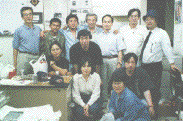
@
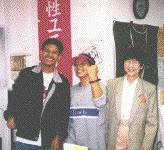
@
@
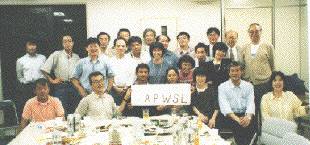
@
@
@
Usually we introduce a
labor-related NGO in this section, but this time we feature a
prominent case of a union in northern Tokyo, the Foreign Laborers
Union (FLU), which is active organizing many Latin American
workers of Japanese descent.@ On the facing page, we include an
article adapted from an English newspaper in Japan about the
difficulties this population of workers has been facing during
the prolonged recession here.
Mr. Nelson Sasaki, a
Japanese-Brazilian living in Yachiyo city, Chiba prefecture, had
both his arms caught in a printing machine and was badly injured
at work on May 13, 1996. Although his arms did not need to be
amputated, his nerves were mangled. He has no feeling in them,
and cannot use his wrists and fingers. He has had several big
operations since then, each lasting about 10 hours, but there has
been little improvement. He needs his wife to help him change his
clothes, have a bath, go to the toilet, etc. So his wife cannot
get an outside job.
He subsequently joined FLU,
Foreigners' Labor Union, and he and the union have tried to
negotiate with Kawashima Kogyo (Industries) Co., Ltd. The
president of Kawashima Kogyo agreed to negotiate, but then
canceled the sessions.
Nelson was hired by a subcontracting
or dispatch company, Kawashima Kogyo. The accident occurred in
Yamada Corrugated Cardboard Company, which Nelson was dispatched
to. The president of Kawashima Kogyo was also an employee of
Yamada Corrugated Cardboard Company. So these two companies are
closely related.
The union tried to negotiate with the
president of Kawashima Kogyo, who is directly responsible;
however, he refused to negotiate. Then it applied for
conciliation by the Tokyo Labor Commission. Nelson has been
getting only 80% of his salary as compensation for not being able
to work, and 30,000 yen for rent is deducted from this. Finally
the union was able to negotiate with the president, with the
conciliation of the Tokyo Labor Commission, on Feb. 19, 1998.
Nelson complained, "It's not just the money, they should
have taken responsibility and given me living compensation
without hesitation." The negotiation continued for 3 hours,
with a break, and we got the following answers:
1. The company will pay back the
480,000 yen rent (30,000 yen/month x 16 months) which had been
deducted from worker's accident compensation, and they will pay
the rent from now on.
2. The company will negotiate his
joining social insurance programs through the union.
3. The company will negotiate
modifying the toilet and shower with the landlord.
4. Nelson will continue receiving 80%
of his salary as workers' unemployment
compensation.
The company will negotiate the additional 20% compensation with the union. Since the company is hesitating about joining social insurance, and adding 20% salary as compensation, the union is not satisfied with the outcome. However, we got some results in the first negotiation. This is not the end. FLU will continue to support Nelson in his struggle against his employer.
This article was adapted from The New Observer, May 1998.
Akimoto Yoko is on the editorial
committee of this newsletter. She is also a member of the
APWSL-Japan steering committee.

@
@
@
@
When Cicero Iboshi abandoned his
farm in southern Brazil and set off for Japan in search of a
better life, he never imagined he would end up unemployed and
living under a bridge.@ But for Iboshi and thousands of other
Brazilian-born workers of Japanese descent, the dream of making
fast money in the land of their ancestors has turned into a
nightmare. As Japan slid into economic chaos this year, it was
the dekasegis (migrant workers) who bore the brunt of the
collapse.
"For months I was jobless and
without enough food. It was really sad to live like that,"
a shaggy-bearded Iboshi told reporters
on disembarking at Sao Paulo, carrying his few belongings in a
couple of his suitcases.@ Iboshi and his girlfriend, Ivete
Sayuri da Silva, slept under a bridge over the Shin River in
Hamamatsu, Shizuoka, for nearly two months before returning to
Sao Paulo, penniless and hungry. Both were fired by employers who
cut back staff, and particularly foreigners, amid the nation's
worst postwar recession.
The couple's humble return reminded
their grandparents of how they emigrated to Brazil at the turn of
the century, fleeing earthquakes and poor harvests in Japan and
setting off on boats for a new life in South America.
Illness rampant
About 3,000 dekasegis in Japan need
medical treatment, according to the Association of Immigrants in
Brazil (Asibras), which is leading a campaign to help sick
workers. Asibras also estimates that nearly 30,000 of a total of
260,000 dekasegis are unemployed.
News of their hardships has shamed the
close-knit Japanese-Brazilian community in Sao Paulo, which
prides itself on the virtues of hard work and self-sufficiency.
Local media have focused on the irony of Brazilians living in
squalor in one of the world's
most developed economies.@ Globo television showed dekasegis
sleeping under overpasses, while Veja news magazine published
photographs of workers crammed into squalid apartments in Japan's industrial center.@ The images prompted
Brazilian airline Vasp, which flies regularly between Sao Paulo
and Japan's second biggest city
Osaka, to offer free return to Brazil.
Known as dekasegis in both Japanese
and Portuguese, the sons and daughters of Japanese immigrants to
Brazil started flooding into Japan in the early 1980s, hoping to
benefit from the country's
economic boom.@ They flowed in the opposite direction of a wave
of Japanese immigrants in the late 19th century, when droves of
poor families left Japan in search of prosperity in Brazil
opening up coffee and tea plantations.@ But as Japan turned
into a world-beating economy, many realized they could earn more
in the land of their forefathers. Tourists offices in Sao Paulo
and Rio de Janeiro took advantage of the disparity and turned
into employment agencies, which helped locate relatives and
arrange jobs in Japan.
Once in Japan, Brazilians worked long
hours, mostly in automobile, car component and chemical
factories, and lived together in cheap apartments to save money.@
Small Brazilian communities were set up in the industrial regions
of Gunma, Aichi and Osaka to make them feel more at home, just as
their ancestors had created "Little Tokyo" in central Sao Paulo. But the dream quickly
vanished.
Dekasegis, considered only contract
laborers, were hit the hardest at the onset of Japan's economic collapse.@ While the Brazilian
communities shared strong cultural ties, the dekasegis could not
afford to own an apartment or a house, leaving them at the mercy
of landlords.@ Many were left homeless, roaming the streets of
Tokyo, rather than face the shame of returning penniless to their
parents in Brazil.
@This article was adapted from the August 8 edition of The Daily Mainichi.
@
I hope our readers
still remember the article on the dispute at CMI (Continental
Micronesia, Inc.) reported in the last issue of this newsletter.
Finally, the unfairly dismissed workers could draw a compromise
out of the management after a series of heated arguments.
Last February Continental Micronesia,
Inc., based in Houston, Texas, forced the Japanese attendants at
Narita to choose between early retirement and annually-based
contract work for up to five years, and the company deliberately
took away jobs from workers who established a union and went on
strike. However, the CMI union fought against and negotiated with
the management steadfastly, and finally, union members got their
positions back on May 18.
Eighteen workers who belong to a local
of the Zenrokyo National Union of General Workers Tokyo District
(Union) accepted the company's proposal for reconciliation with a
wage cut (600,000 yen annually-cut on average) but restoring to
their position as regular employees.
CMI is owned by Continental Airlines,
Inc. Earlier this year, the management of CMI suddenly presented
a restructuring package to all its Japanese attendants without
any clear-cut reasons.@ Nine of 34 Japanese attendants retired
from CMI before the end of March, and seven accepted contract
work. However, eighteen attendants seeking for the security of
employment had a hot argument with CMI over returning to their
old position through collective bargaining.
According to Mutsumi Emch who has
worked for ten years, CMI had some ninety regular workers five
years ago, but cut down the number of the payroll to the current
level of thirty-four. At the Osaka branch, the contract work
system has been introduced on a hourly-wage basis of 1,800 yen
for three years - about one-fourth of workers who chose the
system left CMI each year -; accordingly, the branch has never
hired regular employees for those years.
Emch said, "If all attendants
become contract-based, it would be difficult to keep the safety
of flight, because attendants are supposed to take over the
skills and experiences from their superiors to support pilots.
Usually most of us imagine that the
salary of attendants is so high, but that is not the case with
CMI workers. The average annual income for attendants working for
five to sixteen years is between 4.5 and 6 million yen, depending
on their flight hours, and what is worse, CMI defines their
flight hours only as ones during which a plane doesn't touch the
ground. To take an example, when an attendant works on the flight
for Hawaii and stays at the hotel, the allowances to be paid to
him/her are wages based on his/her flight hours plus just the
cost of meals.
Furthermore, CMI makes it one working
condition that attendants are obliged to work on the flight for
at least 88 hours a month - the level is the longest among
domestic airlines Ρ, hence, attendants has been often forced to
work for long hours at a low wage. CMI attendants have found that
the restructuring package will cause some hardships. The proposal
for reconciliation offered by the company includes the reduction
in the annual income of some 600,000 yen which will certainly
worsen their life.
Emch, secretary-general of the union,
said, "Without any fight or union, we could never expect our
return-to-work as a regular employee, I think. From now on, we
want to negotiate with CMI over maternity leave and exercise the
right to take it through union activities," adding that she
still feels uneasy about what kind of steps will be taken by CMI
for its restructuring. @
@
@
From May 13 to 20, ten postal
workers from Japan visited Aotearoa/ New Zealand.@ This
exchange visit of postal workers was coordinated by the APWSL
committees in both countries. The Japanese postal workers were
welcomed by members of the Postal Workers Union in Wellington and
the Postal Workers Association in Auckland. They were able to
visit post offices, meet posties and stay in their homes. The
highlight of the visit was the two consecutive meetings in which
postal workers from both countries could explain their working
conditions to each other.
@APWSL Japan is very happy that this
exchange program was a success and to have taken part in it. We
hope that this visit will be followed by a visit in return from
Aotearoa/NZ postal workers next year. The tour members from Japan
are now preparing a report of their visit to Aotearoa. Here is
one member's report:
@
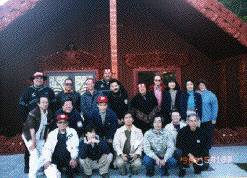
@
by Yoshino Shinji
This visit to New Zealand was my
fifth tour abroad. I have experienced thrilling and even shocking
visits to China, the Philippines and Thai in the past. But this
time it was quite different. This may be because the aim of this
tour was to meet and exchange ideas with ordinary workers in
their daily workplaces and homes. I was able to realize that
workers and people in a weak position in New Zealand are being
victimized by deregulation and reform. Nevertheless, the
strongest impression I had was that this was the land I want to
live in.
I met Ikuko-san in Wellington and had
the chance to speak with her three times. I cannot forget her
words. She is a Japanese who came to New Zealand thirty years ago
and is now working in a post office in Wellington. She told me
that when she started to work she was surprised by the difference
in the work attitude there. Compared to the Japanese standard,
New Zealand workers seemed to be not working enough. But she also
said, "But New Zealand is a good place to live in. If you
want to live in ease after your retirement, why not come
here?" I also thought that the pace of life there was slow
and easy. The working style must have changed in the recent
years, but it still seemed humane compared to that of Japan. In
my hometown, I am now trying to build a community where every one
can live without fear supporting each other. So I cannot leave
Japan, but if I could live abroad, I would want to live in New
Zealand.
Through talking with the postal
workers over there, I felt there was a great difference in the
style of working and living. In Japan workers strive to get
promotions in order to get high wages and sacrifice their family
lives. But in New Zealand there is not such big wage differences
and people work in order to live rather than live to work like we
do in Japan. The members of our visiting group were all critical
of the "corporate warrior"
mentality dominant in Japan. But we
are also seeking a positive identity through our work, such as by
doing socially useful work or work for the public benefit. But
our counterparts in New Zealand place their priority in their
family life or life in the community. I felt sympathy for this
attitude and was happy to find workers with the same feeling as I
have. This sort of identification is something I could not find
in my other visits abroad. This may be the reason why I am
attracted to New Zealand.
Yoshino Shinji is a postal worker
in Japan.@ Yamasaki Seiichi, Secretary-general of APWSL-Japan,
translated this article and wrote the introduction.
@
@
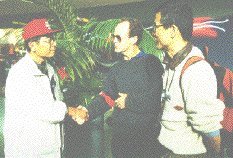
@
@
@
@
APWSL Japan held its 9th annual general meeting in Osaka for the first time on October 3 to 4. The main theme of the discussion was the evaluation of the two recent workers' exchange visits to Japan: one from APWSL Thailand in May and the other from APWSL Aotearoa in August. Both exchanges were successful in bringing workers in direct contact with each other and in strengthening the ties between each APWSL national groups. The exchanges were especially significant in that the visiting members included workers from Japanese TNCs: Thai Suzuki and Juken Nissho in Aotearoa. The visit gave them an opportunity of better understanding enemies they are fighting against and also of learning that Japanese workers are also fighting against the same opponent.
But APWSL Japan also experienced many difficulties in preparing and carrying out the two exchange programs. Difficulties of communication with the visiting groups in the preparation process, setting the focus of the exchange program, financing of the exchange, documenting and evaluation process of the exchange: these were some of the difficulties and problems, which evoked considerable controversy inside APWSL Japan. These difficulties were not directly taken up at the AGM; instead, a set of guidelines for APWSL exchange programs was proposed and discussed. The guidelines were made by summarizing the experiences of the two recent exchanges and tried to set up criteria for future exchange programs. There were some important objections concerning the nature and objectives of the exchange programs. At the AGM, we did not decide on the proposal but agreed to continue the discussion of the proposal.
The other main theme of the discussion was the changes in the structure of international solidarity in the Japanese labor movement and the position and role of APWSL Japan inside that structure. Yamasaki, the Co-coordinator of APWSL Japan, reported on this theme, citing a report made by Ben Watanabe and Yamasaki: On the possibility of reforming Japanese labor movement through international solidarity. This is a case study of the solidarity actions for US workers fighting against two Japanese TNCs in the US: the Bridgestone Firestone and the Hotel New Otani in Los Angeles. Professor Totsuka of the Center for Transnational Labor Studies supported the argument and stressed the importance for APWSL Japan to interact with the main stream labor movement with the intention of changing it. There were objections and doubts to this proposal from members in Osaka, where the relations with the main stream unions are somewhat different from that in Tokyo. The discussion revealed that there were differences of opinion regarding the focus of activities and self-identity of APWSL Japan.
Another subject of heated discussion was over Ben Watanabe's article for this issue of APWSL JAPAN, titled " A personal proposal to the APWSL Council Meeting in Colombo". This proposal was not made to the AGM, so we did not determine our position on the proposal.@ (You can read it on page two of this newsletter ed.)
An exciting new development
reported to the AGM was the setting up of a web page for APWSL
Japan. The address is http://wwwjca.ax.apc.org/~apwsljp/
The AGM discussed the APWSL Council
Meeting in Colombo and decided to nominate Yamasaki as one of the
Co-convenors in order to support the new Coordinator.
At the AGM, the following new
executive members were elected:
Co-representatives@@ Kadokawa (f),
Inada (m), Isu (f), Umatani (m)
Co-coodinators@@@ Yamasaki (m),
Tohno (f), Kitahata (m)
Treasurer@ Nakahara(m)
The AGM was the first AGM to be held
outside the Tokyo Metropolitan area and was successful in
gathering members not only from the Osaka area but also from
Nagoya and Okayama. The meeting was a big step towards spreading
APWSL activities outside Tokyo and Osaka. The AGM was also
significant in exposing the difference of opinions inside APWSL
Japan. I hope that APWSL Japan would continue the lively debate
started at the AGM and reach at an understanding for the progress
of APWSL Japan activities.
@
We apologize for this issue coming
out several months late.@ Originally it was due to come out in
August or September, but we had several delays because of our
various vacation schedules and the writers, translators and
editors being especially busy since the summer.@ One benefit of
the delay is that we were able to carry a report of the lively
AGM held in Osaka last month and a personal proposal by Ben
Watanabe, one of the founding members of APWSL.@ With these two
pieces and the reports of the two exchange programs held in Japan
this year, the newsletter is really becoming a forum for Japanese
workers to express and debate their opinions in front of an
international audience.@ We plan to carry some dissenting
opinions to Ben Watanabe's proposal in the next issue.@ I think
the open expression of disagreement and criticism in this
newsletter should be taken as a sign of the growth and maturing
of APWSL Japan as an organization, although I recognize that not
all the Japanese members are comfortable with this editorial
approach.@ Any comments and criticisms from readers in response
to these pieces are welcome.
At the AGM, it was agreed that John
McLaughlin will continue as editor, although with increased help
from Japanese members in coordinating the writers and
translators.@ Somewhat in exasperation over the difficulty of
this task, I recommended that APWSL consider the alternative of
appending a couple English articles to its more regular Japanese
newsletter and sending it overseas, but we agreed to try to
continue putting out an all-English newsletter on a quarterly
basis.@ The next issue will start Volume 9, but we can expect
to be several months behind in publishing it and it will be
halfway through the activity calendar beginning in July.@
Again, we apologize for the delay but it seems to be the best we
can do given the limited pool of members who can write and
translate into English.
In addition to the writers and
translators, we would like to thank the following people for
contributing to this issue:
@